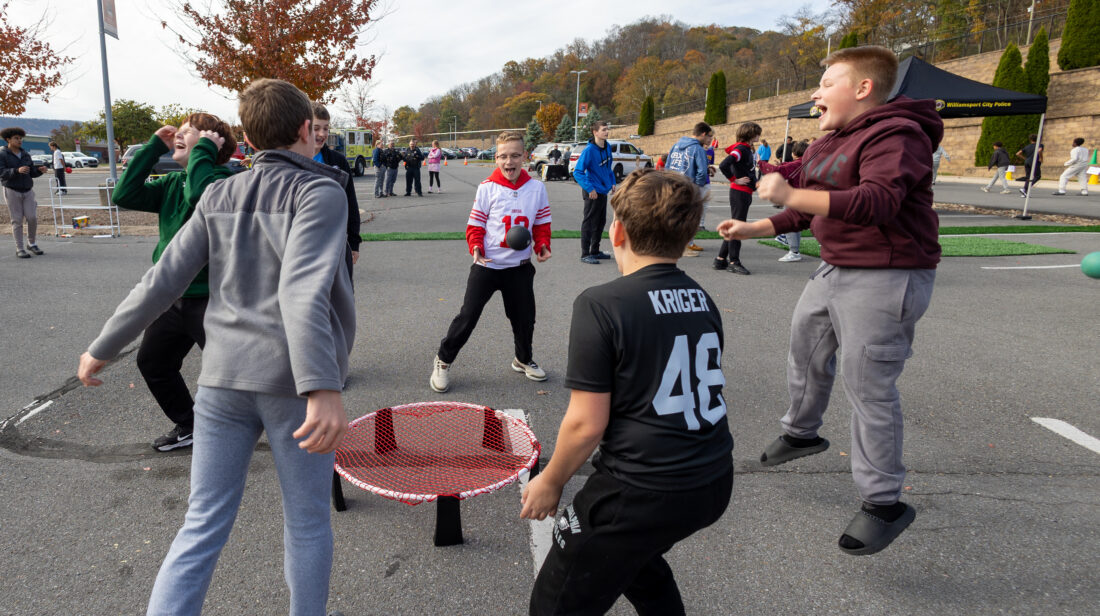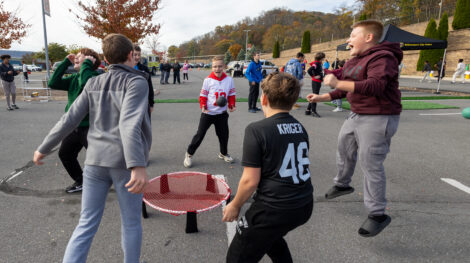Red Ribbon tailgating event highlights community support

KAREN VIBERT-KENNEDY/Sun-Gazette Williamsport Area Middle School students play a game during the "Red Ribbon Week Tailgate at the school. Red Ribbon week included activities to reinforce the shared commitment to promoting a drug-free lifestyle.
Working to keep kids drug free takes a community effort and members of community organizations and agencies turned out for a Red Ribbon Week tailgate party at the Williamsport Area Middle School (WAMS) to do their part..
“The goal is prevention, and then the goal is to make the kids understand, to find some type of passion that is so much of an importance in their life that they would rather do that than distract from their goals,” said Sara Watson, health and physical education teacher at WAMS, who worked with fellow health and physical education teacher Amy Bolt, to coordinate the events for the week. Bolt is also the advisor for the Positivity Club at the school.
Red Ribbon Week was developed in honor of Enrique Camarena who was a DEA agent who was killed while doing his job.
“We wear red ribbons in memory of him and have anti-drug week at the end of every October,’ said Bolt.
About 20 different agencies, some school based as well as students from the high school that are interested in education and have an interest in drug prevention were positioned around the parking lot, offering information and fund games. Representatives from law enforcement, emergency medical personnel and people from the treatment community were also at the event.
“Our goal today is to connect the kids with people in Williamsport who have a vested interest in drug prevention. We want to empower the kids to learn how to use their social skills to say no to drugs and then understand in the event of any family issues that they have resources to go to,” Watson said.
In preparation for the day, the students studied a health education curriculum which provided them with the skills that they need to refuse drugs, Watson said.
“It provides them with background information as to the reasons why to avoid any type of addictive substance. And then this is the final puzzle piece that allows them to visually see what some of the community resources are, the names and the faces, so they can build that community connection and feel comfortable to ever seek out help from someone outside of the school,” she explained.
“It’s all about building a community against drugs,” Bolt said.
“When you’re one person saying no to something, you feel like you’re on your own island and you kind of second guess yourself,” Bolt said.
“We found there’s real strength in numbers. If you want to say no and you know everybody is also saying no, it’s a lot easier to do that. So, the community’s here and we’re just building a culture of healthy decision making,” she added.
Another component of the activities is the mental health aspect, which Bolt said is actually more concerning than the drug education aspect.
One of the major protective factors too, of not using drugs, is having more positive things, more mental health support, more of a well-rounded approach and not just targeting say no to drugs,” Bolt explained.
Scott Shaffer, an eighth grade student at WAMS and a member of the HOPE Squad was helping with one of the games..
“I hope to accomplish better mental health for future kids-for the future generation and I hope everyone just feels welcome to any community,” Shaffer said.
As part of the HOPE Squad, Shaffer said that he has been approached by students that wanted to talk about things that were bothering them.
“I talk to them and if they feel comfortable, I refer them to an adult or I tell them to talk to their parents about it and see if they can set up a therapy session,” he explained.
He said that it’s important to talk with them because, “one word and one sentence can save someone’s life.”
Taylor Falk, from the West Branch Drug and Alcohol Abuse Commission, was helping with an activity where students were tracing their hands and writing on the tracings what motivates them to stay away from drugs and alcohol. The plan was to then form a ribbon with the hands strung together.
Falk said he feels it’s good to get out in the community and give exposure to the kids “about the harms and repercussions of what drugs and alcohol can do.”
He also feels that the middle school age group is particularly vulnerable to peer pressure.
“With this age group, they’re heavily influenced. Not that every other age group of kids aren’t heavily influenced, but I think they’re very impressionable,” he said.
“At this age they can give in to peer pressure, so I think the realities of this situation are they would be more likely to engage in drugs and alcohol-experiment because I think especially at this age you’re naive. You probably don’t think things through all the way,” he said.
Trooper Lauren Lesher and Corporal Jen McMunn, of the Pennsylvania State Police (PSP) also were present at the event. They echoed Falk’s thoughts about peer pressure.
“They just need to know, if you’re ever in those situations, that they need to step away from those citations and remove themselves from that group of kids that may be trying to use experimental types of stuff,” McMunn said.
“We always like to let them know that you are who you associate with,” said Lesher.
“So, if your friends are making poor choices and you’re constantly pulling yourself away from it, you might have to change your friend group because that’s going to just pull you down and you don’t know what career path that you might take,” Lesher said.
“Depending on what you get into, especially with the PSP, we do a very thorough background check…it’s definitely not something they think about at this age, because they’re thinking about friends, but you are who you associate with,” Lesher added.


